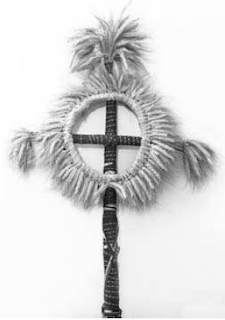Figurine of a bearded man by the Naqada I culture, 3800–3500 BC, from Upper Egypt. Pic by Rama.
Today I came across this article "Heliopolis and the Solar Cult in the Third Millennium BC"
In it I read about the "Souls of Heliopolis", "Souls of Hierakonpolis" and Pharaohs as great prophets, great seers, who received their sacred knowledge and legitimacy from their ancestors...all the way to the procreator god..."
And this got me thinking: Was ancestral worship at the core of the early Ancient Egyptian religion? Is this why Pharaohs wore false beards?
Apparently, Pharaohs (divine rulers) wore false beards to signify their status as a living gods.
And not any god. Osiris. In ancient Egypt, Osiris was considered as being the perfect example for pharaohs...
Thus, in order to get closer to and bond with the perfect pharaoh Osiris, his pharaonic successors wore a false beard to imitate his appearance. But Osiris didn't actually have a real beard himself...
Osiris, wore a false beard in his role as ruler of underworld while he judged the dead. Apparently, he wore the false beard "as a symbol of his great wisdom"...
Why would a beard be a symbol of great wisdom? Cause beard is a symbol of an elder, an ancestor...Someone of a great age with great experience and hence knowledge, wisdom...
The older you were, the wiser you became...And longer your beard grew...
And then you died and went to the underworld. So the underworld was full of dead ancestors with long beards...
So Osiris wearing a false beard while judging the dead, was symbolically proclaiming the judgement of the ancestors...Cause it was really the ancestors who judged their descendants...And gave them what they deserved...
Remember this?
"...humiliation of the Hittite kingdom is the result of the fact that the Hittites have forgotten to respect the sacred bond with their dead..." - Last Hittite king Suppiluliuma II. I talked about this in my post "House of bones"...
Statue of Suppiluliuma II, Hatay Archeology Museum, with a pretty depressed looking expression on his face...
In the above post, I proposed that what caused the demise of the Hittites was a severe multiyear drought, and that to understand why Suppiluliuma II talked about the dead, we need to look at the beliefs of Serbs and other Balkan Slavs. In the Balkans people believed that if the dead were not given water, they would drink it from the clouds, and would cause drought. You can read more about the eternal thirst of the dead in my post "Thirst"
Romans linked rain, and agriculture, with the will of the dead too...You can read more about this in my post "Lapis Manalis" about the Roman agricultural rituals which link the (thirsty) dead living under (holy) stones, rain and agricultural fertility...
It turns out, that I was right. According to this recent article from Nature, "Severe multi-year drought coincided with Hittite collapse around 1198–1196 BC"...
In Egypt, agriculture depended not on rain, but on the annual Nile flood. And who was the god directly linked to the annual Nile flood that created the black (fertile) soil? Osiris.
Osiris with wheat growing from his body. From the coffin of Nespawershepi.
I talked about the link between annual Nile flood, fertile black soil and Osiris in my post "Holy carp"...
Osiris the Perfect Pharaoh. He who made the land fertile and who liked to wear a false beard, pretending to be symbolic ancestor...Did Ancient Egyptians also have in their religion the link between the dead and water and fertility? I think so...
Osiris, who was thus emulated by the Pharaohs who wore a false beard to pretend to be Osiris (who wore a false beard to pretend to be an ancestor 🙂)...
What was the most important role of a Pharaoh? To feed his people of course...
BTW, this is Diduch (Grandfather, Ancestor), depicted as a sheaf of grain, to symbolically show the link between the dead and the grain fertility...I talked about this in my post "Diduch"
This was fun 🙂 What do you think?
I want to thank my friend @another_barbara for this great insightful comment:
I've been thinking about the things you posted since last night. People "planted" their dead in the soil that fed them, scatter their ashes into life giving rivers or seas that provided for them...

































